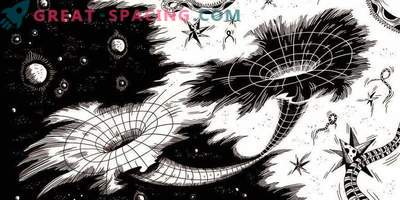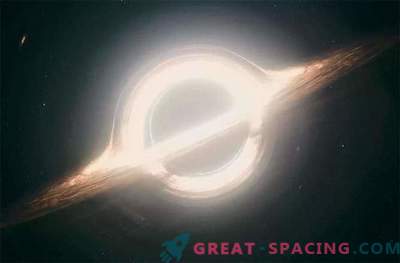
Black holes have always remained simple in our imagination.
There was a time when, using the rules of the general theory of relativity, one could imagine a dense infinite singularity. It was surrounded by a gravitational zone, from which it was impossible to escape, and was called the “event horizon”. These components, together with several additional details, constituted the basic description of the anatomy of a black hole.
The textbook is written about this very clearly: nothing, not even a ray of light can break through the gravitational vice of the object's event horizon. It's just a one way ticket. If an astronaut is too close to the event horizon, he will be dragged inside. And he will have to fall to his death, expecting terrible consequences from spaghettification.
Although this is a simplified form, it served as a fairly decent explanation of what happens in the black hole. But in the 1970s, the British guru of theoretical physics, Stephen Hawking, presented his main theory of evaporation of black holes. And in modern times, Hawking believes that textbooks were wrong, leading us to the idea that blacks look like one-way streets.
Hawking radiation problem
The complexity of the fact that black holes can evaporate is a consequence of the weirdness of the unexplored quantum world. Quantum theorists suggest that in the vacuum space a pair of “virtual particles” constantly jump out of space and return to it. So, it turns out that the “true vacuum” is never empty. In fact, it is filled with pairs of quantum particles that are born into the world, and then annihilate in a tiny interval of time. Usually such a process takes place without a hitch and a hitch - particles arise from a vacuum, then they annihilate with their partner and the Universe does its own personal business. But, if you add a black hole to the mix, then everything around you acquires the features of madness.
As we mentioned above, the event horizon in a black hole becomes a point from which there is no return. So what will happen when a pair of virtual particles soars in the general existence on the horizon and only one falls inside? Well, the second “virtual particle”, which has lost its annihilation partner, is literally driven out of the black hole and becomes the “reality” category. In the process of becoming a “reality”, this particle takes a part of the mass from the black hole (quantum mechanics never claimed to convey a logical meaning). Because of this process, constantly raging in the horizon of events, the black hole begins to lose physical mass. This is what Hawking radiation evaporation is.
Up to this point, I only warmed up your appetite for the oddities of quantum field theory, and then it will only be weirder. But first we need to touch on some additional information.
The general theory of relativity and quantum field theory play among themselves by the rules. Both areas of physics deal with fundamental descriptions of space, time and matter at the micro (quantum) and macro (cosmological) levels. They are located on opposite sides of the scales. And after the recent discovery of the Higgs boson, the quantum “book of recipes” called the Standard Model, once again helped prove that this is an accurate description of how our Universe works.
The Standard Model seems to have a fundamental problem with gravity. So far, physicists have not been able to find a particle that mediates in gravitational force (the hypothetical name is “graviton”). And despite all their efforts, it seems that there is still no way to solve this puzzle. And in recent years, black holes have become another battleground between the general theory of relativity and quantum field theory.
Antithesis of “No Drama”
When matter (and hence “information”) enters the space of a black hole, it is removed from the known limits of the Universe and is effectively destroyed. This is a problem. The general theory of relativity cares little for information that matter possesses. But quantum theory, on the other hand, is too much interested in this information and believes that it cannot be “cleared”.
In 2004, a famous event occurred when Hawking admitted defeat in a dispute with theoretical physicist John Presquil. He confirmed that information “lost” in a black hole is encoded in Hawking radiation (he initially claimed that black holes destroy information, and information in radiation is a new code that does not relate to an object entering the hole).
But this quick fix created another problem. In 2012, a group of physicists led by Joseph Polchinski of the University of California at Santa Barbara realized that storing information in Hawking radiation would require a “firewall” of strong quantum energy that would squeeze everything beyond the horizon of events.
Recalling our hapless cosmonaut who got into the horizon of a black hole event, with the general theory of relativity, he will not experience anything while drifting through this area (of course, if it was not Matthew McConaughey who would see bright lights). Naturally, in the end, the astronaut will break into small pieces, but it will be burned. Such a thought experiment is known as the no drama postulate.
But everything changes the impasse from the firewall. He simply violates the laws of drama and creates the exact opposite. That is, it completely violates the general theory of relativity and the theory that controls the black hole with which we started.
So now physicists have to fight with the equations and try to solve the “information paradox”. This is what the greatest minds have been doing in recent decades. Stephen Hawking himself does not even leave this debate. For example, last year he discussed the possibility of replacing his theory with a theoretical construct known as the “apparent horizon” rather than certain boundaries. Perhaps this concept needs to be improved and in fact this horizon changes its formation in response to quantum fluctuations inside a black hole. This creates a chaotic disorder in the information beyond the apparent horizon, which neither violates the laws of quantum dynamics, nor the general theory of relativity.
“Thus, as the prediction of weather on Earth, information will be effectively lost if there is no loss of unitarity,” Hawking wrote in an article. This means that, although the information may be released from the black hole, its randomness cannot be interpreted without solving the problem with the firewall.
Needless to say, this is not the end of the debate between Hawking's peers.
And now Hawking, appearing on the news at the Royal Institute of Technology in Stockholm on August 24, gave his exquisite explanation through a public lecture. He told me that he was thinking over the wire processing information in black holes.
“I believe that information is not stored in the middle of a black hole, as one might think, but on its border, in the event horizon,” he said at the lecture.
The scientist explained in detail that information is stored on objects that fall into a black hole, and is converted into 2-dimensional holograms, after which they are captured in Hawking radiation and removed from the black hole. But there is no romance in it, because it does not look like a super-advanced computer hard drive. Instead, it’s a real chaotic mess.
“I think black holes are not at all the same color as they are described,” he explained. - “They do not constitute an eternal prison, as previously thought. Things can go from the hole to the external or to other universes. ” We are awaiting the documents that Hawking and his staff intend to publish within a few weeks in order to understand what he meant by the word “other” universes. But there are assumptions that make it clear that holes can serve as a door to parallel worlds or even full universes.
Event Horizon Telescope
At present, Hawking may have formulated an “emergency exit” to obtain information from a subject that has fallen into a black hole. But we will not be able to accurately know the process until we fully study the nature of these objects.
Astronomers from the Event Horizon Telescope are close to seeing the deep core of our Galaxy. They can see the projected disk of light that surrounds the supermassive black hole of the Milky Way, Sagittarius A, located at a distance of 20 thousand light years.
“For so many years, Hawking has been trying to find solutions to the information paradox: either to tune it so that quantum field theory combines with general relativity, or to change the way to view a black hole,” writes Dimitrios Psaltis, a professor of astronomy and physics from the University of Arizona . “If everything works out with the second option, the Event Horizon Telescope will be able to see a unique view.”
Hawking's work can put forward new cutting-edge ideas and provide an opportunity to consider some aspects of the information paradox.











































